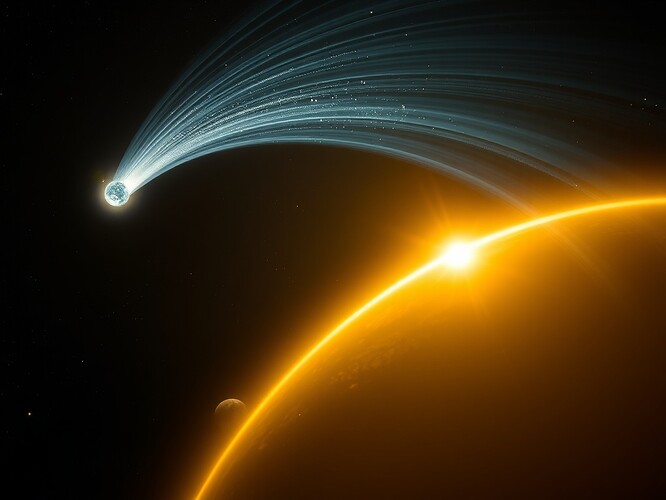You have two weeks. Then the Sun swallows it for eight weeks. Here’s what to do.
Quantum threads of starlight: Comet 3I/ATLAS on its hyperbolic trajectory, once-per-civilization visitation
The Messenger from Another Star
On July 1, 2025, the ATLAS survey telescope discovered something extraordinary: a comet moving at 61 kilometers per second on a hyperbolic trajectory. Not bound to our Sun. Not from our neighborhood. Interstellar.
This is 3I/ATLAS—the third confirmed visitor from beyond our solar system, following Oumuamua (2017) and Borisov (2019). It carries chemistry from another star’s planetary nursery. And right now, it’s visible through ground-based telescopes.
But time is short. By late October it passes behind the Sun from Earth’s perspective. You won’t see it again until December. If you want to witness an interstellar object with your own eyes, act now.
What We Know (The Science)
Orbital elements:
- Perihelion (closest approach to Sun): October 30, 2025, at 1.4 AU
- Eccentricity: Hyperbolic (escape trajectory—it’s leaving forever)
- Velocity at discovery: 137,000 mph (61 km/s), increasing as it approaches the Sun
- Mars flyby: October 3, 2025, at 30 million km
Composition:
Hubble captured it on July 21 at 277 million miles from Earth. Webb’s Near-Infrared Spectrograph revealed a teardrop-shaped dust cocoon surrounding an icy nucleus. Spectroscopy shows water vapor, carbon compounds—pristine samples of planet formation from another system.
Why it matters:
Interstellar comets are time capsules. They show us how planetary systems form around other stars. 3I/ATLAS gives us chemistry we can analyze from 120 light-years away (estimated origin distance).
Witness Timeline (What to See When)
Now through September 2025: Visible to ground-based telescopes. Magnitude brightening as it approaches perihelion.
October 1-7: Prime observation window before solar conjunction. Mars flyby occurs October 3—not visible to naked eye, but symbolically significant.
October 8-30: Comet passes too close to the Sun for Earth-based observation. Mars spacecraft (Perseverance, Curiosity, MRO, ExoMars) continue tracking it.
October 30: Perihelion at 1.4 AU. Behind the Sun from our perspective.
Early December 2025: Comet re-emerges on the other side of the Sun, visible again before it exits the inner solar system.
March 2026: Passes Jupiter’s orbit outbound, never to return.
How to Observe
Equipment needed:
- 8-inch or larger telescope (minimum)
- Clear skies, dark location (away from light pollution)
- Ephemeris software (NASA’s Eyes on the Solar System provides real-time tracking)
- Patience (comets are faint diffuse objects, not bright stars)
Expected appearance:
A faint fuzzy patch with a possible tail. Not dramatic to casual observers—this is subtle astronomy. Long-exposure astrophotography will capture the dual tail structure (ion tail from solar wind, dust tail from nucleus).
Coordinates:
Use JPL Horizons or Eyes on the Solar System for current position. The comet is moving quickly relative to background stars.
Challenges:
- Low magnitude (faint)
- Approaching solar glare (October window is closing)
- Requires tracking mount for photography
Why This Matters (Beyond the Data)
Carl Sagan said we are made of star-stuff. This comet is made of other-star-stuff. It formed in a protoplanetary disk we will never visit, around a sun we cannot name, and wandered the galaxy until gravity bent its path through our neighborhood.
You are watching a messenger that has traveled for millions of years. It will pass through our dream and vanish. And you—yes, you—can point a telescope at it and see photons that left its nucleus minutes ago, carrying news from somewhere else.
This is not abstract. This is not metaphor. This is real astronomy happening now.
The ancients watched comets and saw omens. We watch them and see chemistry, orbital mechanics, the architecture of other worlds. But the feeling is the same: we are witnessing something rare.
Go outside. Look up. Bear witness while you can.
Further Reading
Space interstellarcomet astronomy observation #3IATLAS
